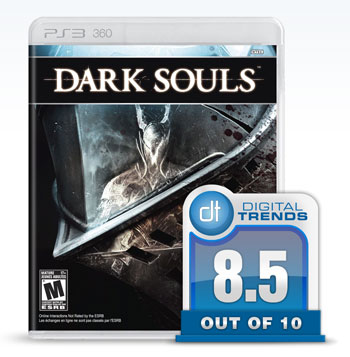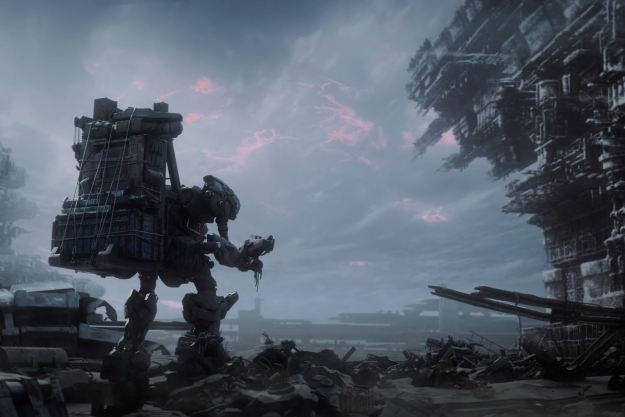 In Dark Souls, From Software takes the impossibly challenging gameplay from its 2009 release Demon’s Souls and refines it. The result is a resounding success, building on the basic tenets laid out in the original with some new gameplay systems that completely alter the flow of play, making this week’s spiritual successor at once more welcoming and more challenging to all players.
In Dark Souls, From Software takes the impossibly challenging gameplay from its 2009 release Demon’s Souls and refines it. The result is a resounding success, building on the basic tenets laid out in the original with some new gameplay systems that completely alter the flow of play, making this week’s spiritual successor at once more welcoming and more challenging to all players.
Dying to learn
At base, Dark Souls is an action RPG bolstered by a complex set of progression and combat systems. But that sentence hardly captures the essence of the game, or really, the series.
Much like its 2009 predecessor, this game is not for the faint of heart. Instead of rewarding success, it punishes both ignorance and unskilled play. Discovering a new area for the first time? You will die. Taking a crack at a boss, or in some cases an enemy type, you’ve never faced before? You will die. Going into battle with anything less than 100 percent of your attention fixed on the game?
Yup, you’re going to die. In fact, even allowing for proper amounts of prep time to handle all of these various challenges, you’re still going to die. A lot. But there is an education in your demise.

For all of the challenge it throws in your direction, Dark Souls is successful first and foremost for letting you learn from your mistakes and adjust your style of play accordingly. The cost of losing a life is relatively minimal; any souls or humanity (two forms of in-game currency) that you’ve collected are dropped right where you die — waiting to be recovered if you can get back to that spot without dying again. The only real penalty beyond that is a one-way ticket back to the last bonfire you healed at.
Back to the grind
Bonfires represent a big change from Demon’s Souls, and they serve to greatly improve the flow of the play in this new release. Think of a bonfire as a checkpoint save: Sitting down at one immediately restores your health and makes you fresh for battle again. It also refills your stock of Estus flasks, the game’s key quick-use health restoration item. Eventually, you can repair and upgrade your equipment at these fires as well.
Since nothing in Dark Souls comes without a price, the one you pay for daring to rest and recover your health is the respawning of all enemies that you’ve defeated since your last bonfire sitdown, save for bosses and mini-bosses. This element makes the game very grinding-friendly; simply find an enemy-rich area that’s close to a bonfire, then kill, rest, rinse, repeat to your heart’s content.

You’ll need the added power too, as even the lowliest of enemies can quickly bring you down if you’re not careful. Grinding is essential, and you’ll be doing a lot of it. Fortunately, the level of attention that any individual encounter demands also prevents the repetition from growing stale too quickly. By the time you’re powerful enough to easily — if smartly — handle any enemies in a given area, you’ll be ready to move to the next one.
While Dark Souls is never easy, it delivers a lot of entertainment value to those who are willing to learn the game’s systems. Those who try to take shortcuts or rush through areas will inevitably be punished, and quickly grow frustrated if they end up setting their home bonfire in a location that’s too far ahead of their power level.
Who said life would be easy?
There is loot of all kinds to be collected, and other secrets to be discovered, but the real rewards are far less tangible for skilled players. There is something indescribably satisfying about bringing down a boss, or even a particularly tough standard enemy (Black Knights can seriously suck), in this game.
There are those in the industry who call out recent titles for being too forgiving; Dark Souls challenges that notion at every turn. The big success here isn’t just that; it’s also that this game entertains rather than frustrates. Sure, you’ll get plenty mad when you accidentally stumble into a mini-boss fight and lose the 10,000 souls you’ve amassed, only to make a stupid mistake and die on your way back to retrieve them. It will always be your fault though. Dark Souls may be challenging, but it is never cheap.
The unusual online features seen in the first game return here as well, with players able to leave notes scattered around the world that others can see. These notes typically offers a heads-up about what lies ahead or some secret that’s hidden in the area, but there are some sadistic players out there in the world too. People who will tell you about this great treasure hidden around the next corner… when it’s really just a Black Knight waiting to bop you over the head with his giant sword.

You can also invade another player’s world — or be invaded yourself — to earn extra souls and humanity. Souls function as the game’s most basic currency; you spend them on anything from character-leveling stat points at your bonfire to shop items from various merchants.
Humanity is a bit trickier. Your character is technically an undead being, so using one humanity at a bonfire to “reverse hollowing” makes you human again. You can then spend a second humanity at that bonfire to “kindle” it, which essentially upgrades that particular fire to give you 10 Estus flasks whenever you rest there, as opposed to the usual five.
Almost perfect
The story is this game’s main weak point. It has one to tell, but it doesn’t do so very well. A large part of this can be blamed on the need to spend multiple hours grinding up to higher and higher power levels, but it doesn’t change the fact that the story, which gets a fair amount of development at the start of the game, fails to manifest very frequently as you play.
There’s also just the general user-unfriendliness. It’s not really fair to shower an unforgiving game with praise and then complain about it being unforgiving, but the level of challenge will almost certainly keep the wider gaming audiences away. Dark Souls separates the hardcore from the casual. It’s not necessarily a strike against the game, but it unquestionably limits the audience.
Those minor issues aside, Dark Souls is another examplary From Software effort and a near-perfect evolution of its predecessor’s basic ideas into a more compelling gameplay experience. Not everyone can enjoy it, but those who do will sing its praises to one and all.
Score: 8.5 out of 10
(This game was reviewed on the Xbox 360 on a copy provided by Namco Bandai)
Editors' Recommendations
- Hyper Light Breaker is a colorful mix between Risk of Rain and Dark Souls
- How to use Great Runes in Elden Ring
- The PS5 games with the best graphics
- How to unlock the Dark Crusader class in Lords of the Fallen
- Alone in the Dark: release date, trailers, gameplay, and more


